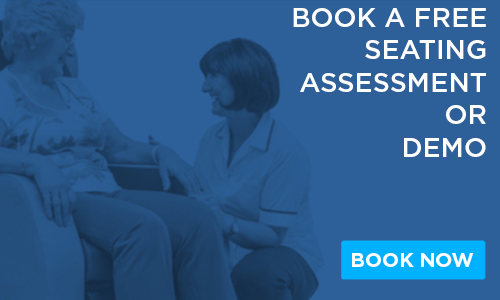Beliefs about the value of bedrest began to shift in the mid-1940s. It was found that soldiers in the Second World War, forced to get up and about quickly because of a lack of available bed space, recovered more quickly from their injuries and infections than would have been expected.¹
“Bedrest’s appropriate objectives are 3- fold: to provide rest for the exhausted, to decrease oxygen consumption, and to reduce pain or discomfort.2 “
Immobility due to Illness or Injury
When suffering from a critical illness or following injury a patient might need bed rest in which to recover.
It takes about four weeks to recover from atrophy caused by immobility – a slower process than recovery from direct muscle trauma (Halar, 1994). Disuse weakness is reversed at a rate of only 6% per week with exercise.5
Falls Risk
We find that patients at risk of falls and who need constant repositioning/are challenging to seat sometimes can be kept in bed as it is thought to be the only way to keep them safe.
Manual Handling Risk
Patients with a bariatric condition or who need constant repositioning might be put on bed rest to limit the manual handling risk to the patient and to the caregiver.
Lack of Resources to Facilitate Effective Repositioning
Repositioning to avoid pressure injuries is required throughout the day and sometimes two caregivers are essential to complete this per patient. In facilities where this is too much of a strain on resources, solutions such as air alternating mattresses might seem like the only reasonable option to ensuring the pressure is redistributed throughout the body reducing pressure risk.
Lack of Knowledge/Education on Seating and Solutions Available
A common barrier to getting people out of bed and into a proper chair, is the fundamental lack of knowledge of the seating options available and of the impact seating has on a patient’s health and quality of life.
Fixed Contractures/Deviated Posture
If a patient presents a fixed scoliosis or kyphotic posture they might be resigned to bed rest as a perceived only option. However provision of a correct seating assessment, accessories and adaptations can accommodate and address deviated postures through seating.
Skin breakdown/Pressure Injuries
Typically through the years the focus when thinking about relieving pressure injuries and providing pressure management, has been on surfaces: i.e. beds, mattresses, and cushions. It’s often been the case that a patients pressure care needs are managed on a pressure management surface for much of the day, and then they are often moved into an unsuitable chair or standard wheelchair with a pressure cushion, which provides inadequate postural or pressure support effectively eliminating the benefits accrued by the mattress/surface. In laying, the oxygen flow is reduced which contributes to further skin breakdown.
Prolonged bed rest has been proven to have extensive negative psychological & physiological effects on the patient. Getting patients out of bed and into a proper chair will not only aid their recovery time it will expedite hospital discharge.
Psychological Impact of Prolonged Bed Rest
-
Learned Helplessness
Prolonged bed rest can lead to learned helplessness, through a sustained loss of control over daily activities and regimes.
-
Fatigue and Depression
Disuse of muscles and immobility create joint or bone stiffness, which leads to symptoms of profound fatigue, lack of motivation, depression, and contributes to a vicious cycle of immobility and decline. 2
Physical and Physiological Impact of Prolonged Bed Rest
-
Respiration
Many studies have shown that prolonged bedrest dramatically increases the risk of respiratory tract infections. Laying in supine position as opposed to sitting up impacts on a person’s ability to breathe properly possibly contributing to recurring lung infections. Additionally, people cannot cough as easily or as well, which allows pooled mucus to stagnate and reduces the clearance of potentially pathogenic material and irritants. 1
-
Digestion/Swallowing/Elimination
Dysphagia and choking is a risk since swallowing in the supine position is more challenging than when sitting. The gastrointestinal tract slows, and food takes 40% longer to be digested and eliminated when a person is supine. 2 The decreased mobility and fluid intake may lead to constipation, bowel impaction and ineffective digestion. This has a knock on effect to the patients appetite, they may want to eat less and less, and eventually might stop eating. Dehydration can occur and urination can become less effective, as the bladder tends to retain fluid instead of emptying it. This can cause urinary tract infections and increase the risk for bladder and kidney stones.3
-
Muscle Atrophy & Weakness
A loss of muscle strength at a rate of around 12% a week. After 3-5 weeks of bed rest, almost 50% of muscle strength is gone. 4
Social Impact of Prolonged Bed Rest
In bed rest the patient is restricted from spending time in communal areas of a home or care facility. When they can be transferred to a suitable chair that meets their postural and pressure care needs, they can join others in the day room, living room or at the dinner table, as a chair is much more mobile than a bed.
-
Social Interaction/Communication
When on bed rest it is more difficult to interact with others as opposed to when sitting upright. Sitting upright enables eye contact to be made more easily with others and makes communication easier for the patient as well as the caregivers and friends and family, which in turn increases the patients motivation to get involved with acitivities around them, or conversation.
-
Involvement in ADLs
A sitting rather than laying position enables more functionality, possibly enabling a patient to take part in activities of daily living such as reading, writing, self-feeding and personal care, more independently than before.
-
Quality of Life
Overall – health, wellbeing and quality of life are significantly improved when sitting up can be achieved and bed rest is reduced.
- Quicker discharge from rehab or hospital which also means a quicker recovery from illness or injury.
- Increased function, more independence.
- Better overall pressure management – reduces risk of pressure injuries.
- Overall health and wellbeing is positively impacted.
- Families and caregivers happier to see their loved one/patient out of bed and sitting comfortably.
- Improved social interaction, communication, inclusion, and increased motivation.
Best results are achieved when proper therapeutic chairs are used in conjunction with pressure relieving beds and mattresses to manage pressure care and postural needs over a 24 hour period.
Overall health and well-being improves when sitting opposed to laying – digestion, elimination, respiration, as well as cognitive health and well-being and motivation for activities such as feeding, communicating, socialising and personal care are all positively impacted.
For patients in palliative care who are at the end stage of their life, being able to get these patients out of bed and sitting comfortably in a chair means a great deal to them and their families. The families often think “They are having a better day today – it’s great to see them out of bed.”
We often link being in bed to being ‘sick.’
A seating assessment should be carried out by an Occupational Therapist, Physiotherapist or qualified Seating Specialist, to determine the extent of the postural and pressure management needs of the patient. The impact of specialist, individualised seating solution positively affects the patients’ health and quality of life in many ways from supporting posture, reducing the risk of pressure injuries, and most importantly, providing comfort. When proper seating with real clinical evidence is used to apply the Four Principles of Pressure Management, optimum results can be expected. This goes far beyond the typical idea that a pressure cushion is enough. Thorough seating assessments & adjustable chairs can keep patients safe and secure, reducing need for time spent in bed and overall aiding a quicker recovery and a better quality of care and patient outcomes.
BOOK A FREE, CLINICAL SEATING ASSESSMENT AND CHAIR TRIAL
REFERENCES
- DeLaune SC, Ladner PK. Fundamentals of Nursing, Standards & Practice. 2nd ed. Clifton Park, NY: Delmar; 2002. – See more at: http://www.pharmacytimes.com/publications/issue/2011/january2011/featurebedrest-0111#sthash.uRJFEdun.dpuf
- Jiricka, MK. (2008) Activity tolerance and fatigue pathophysiology: concepts of altered health states. Essentials of Pathophysiology: Concepts of Altered Health States. Philadelphia: Lippincott Williams & Wilkins
-
Halar, E.M. (1994) Disuse syndrome. In: Ross, M. et al (eds) Recognition and Prevention in Chronic Disease and Disability: a Contemporary Rehabilitation. New York, NY: Demos Medical Publishing. – cited in http://www.nursingtimes.net/effects-of-bedrest-3-musculoskeletal-and-immune-systems-skin-and-self-perception/5003298.fullarticle
** This post was originally published on http://blog.seatingmatters.com/seating-v-bed-rest-for-posture-and-pressure-care


